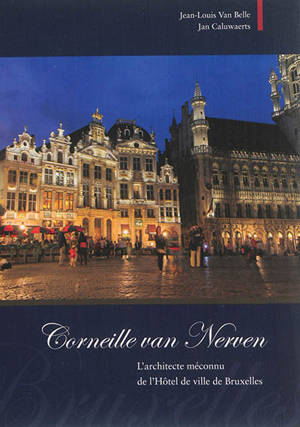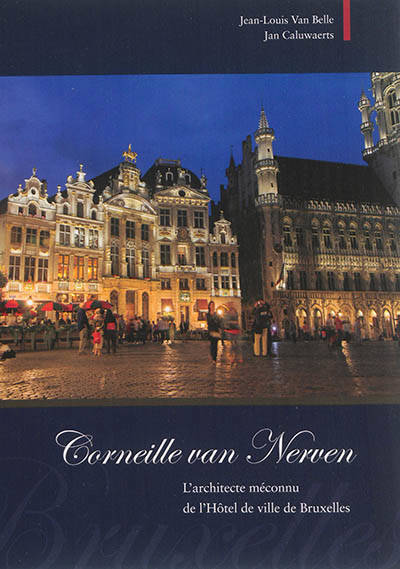
- Retrait gratuit dans votre magasin Club
- 7.000.000 titres dans notre catalogue
- Payer en toute sécurité
- Toujours un magasin près de chez vous
- Retrait gratuit dans votre magasin Club
- 7.000.0000 titres dans notre catalogue
- Payer en toute sécurité
- Toujours un magasin près de chez vous
Corneille van Nerven
l'architecte méconnu de l'Hôtel de Ville de Bruxelles
Jean-Louis Van Belle, Jan CaluwaertsDescription
Corneille van Nerven est assurément un architectesculpteur
au destin mal connu, voire ignoré. Et pourtant
la Grand-Place de Bruxelles, et en particulier l'Hôtel
de Ville, que viennent admirer des touristes du monde entier,
lui doivent une part de l'aspect qu'ils ont aujourd'hui.
Actif après le bombardement de Bruxelles de 1695, il fut
un grand artisan de sa reconstruction. Ce livre dévoile son
activité multiple aussi bien à Bruxelles qu'à Malines (tombeau
de l'archevêque de Precipiano), qu'auprès du marquis
de Mérode-Westerloo et aussi en Écosse (château de
Kinross). Membre d'une famille d'artistes (peintres, sculpteurs)
venus des Pays-Bas - son père oeuvrait à Rotterdam
avant de s'établir à Bruxelles - qui se fixèrent non seulement
en Belgique, mais également en France aux XVIIe et
XVIIIe siècles, il en est le plus illustre représentant.
Cette étude, après avoir situé le personnage dans son
milieu d'artisans bâtisseurs, tente d'éradiquer les zones
d'ombre qui couvrent encore cette personnalité énigmatique
que l'histoire s'est empressée, après son décès, de
plonger dans un certain oubli.
If you happen to visit and admire the "Grand-Place"
in Brussels - and especially its famous
Town Hall - as thousands of tourists from all over the
world presently do every year, you most probably won't
be aware that an important part of the aspect they have
today is due to the work of an architect-sculptor who
would deserve to be better known than he is. After the
bombing of Brussels in the year 1695, Corneille van
Nerven and his teams set about rebuilding and restoring
the picturesque buildings surrounding the famous
Market Place.
This book is about his manyfold activities as well
in Brussels as in Malines (the grave of archbishop de
Precipiano is really worth seeing); as well in the castle
of Marquis de Merode-Westerloo as in Scotland (where
we can admire the Kinross castle). Corneille was the
most famous member of a family of artists (painters
and sculptors) having come over from the Netherlands
(his father worked in Rotterdam before settling down in
Brussels) who took up their abode not only in Belgium
but also in France during the seventeenth and eighteenth
century.
This study - in French -, after trying to situate
Corneille van Nerven in the circle of craftsmen and
builders of his time, strives to "eradicate" the shady
sides, which still cover that very enigmatic artist, who,
soon after his decease-and most undeservedly-, almost
completely disappeared from History.
Cornelis van Nerven is ongetwijfeld een architect-beeldhouwer
over wiens levensloop we voorheen
nauwelijks ingelicht waren. Dit mag verwonderen,
want een belangrijk deel van het huidige uitzicht van de
Grote Markt in Brussel, en in het bijzonder het stadhuis
waar toeristen van over de hele wereld naar komen kijken,
is aan hem te danken. Hij is vooral gekend als architect
van de reconstructie van Brussel, d.w.z. actief na het
bombardement van 1695. Dit boek onthult zijn meervoudig
talent, actief in Brussel, in Mechelen (het graf
van aartsbisschop de Precipiano), als bij de Markies de
Merode-Westerloo, zelfs in Schotland (Kinross Castle).
van Nerven behoorde tot een familie van Nederlandse
kunstenaars (schilders en beeldhouwers), zijn vader
werkte in Rotterdam voordat hij zich in Brussel vestigde.
Cornelis was, van deze familie die zich tijdens de zeventiende
en achttiende eeuw niet alleen in België maar
ook in Frankrijk vestigde, ongetwijfeld de meest illustere
vertegenwoordiger.
Deze studie - in het Frans - tracht, na het situeren van
Cornelis van Nerven in zijn milieu, nieuw licht te werpen
op zijn raadselachtige personaliteit. De geschiedenis
beeft hem lange tijd in de vergetelheid gedompeld, maar
met deze studie verdwijnen heel wat schaduwzones uit
het leven van de grote kunstenaar.
Spécifications
Parties prenantes
- Auteur(s) :
- Editeur:
Contenu
- Nombre de pages :
- 111
- Langue:
- Français
Caractéristiques
- EAN:
- 9782874570810
- Date de parution :
- 25-08-14
- Format:
- Livre broché
- Dimensions :
- 170 mm x 240 mm
- Poids :
- 320 g

Les avis
Nous publions uniquement les avis qui respectent les conditions requises. Consultez nos conditions pour les avis.






